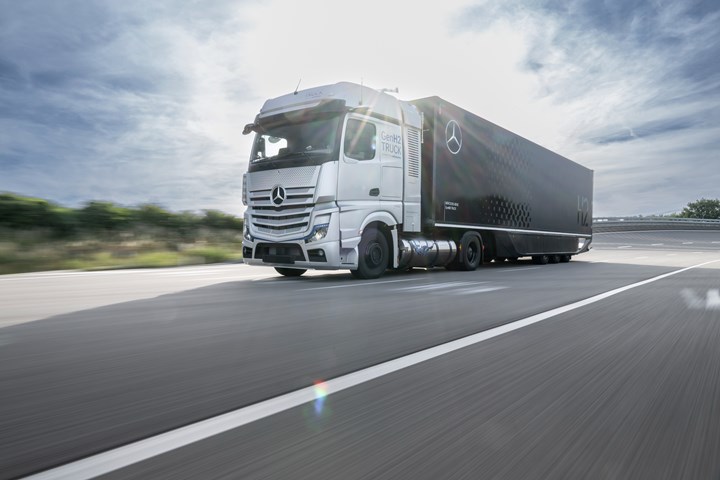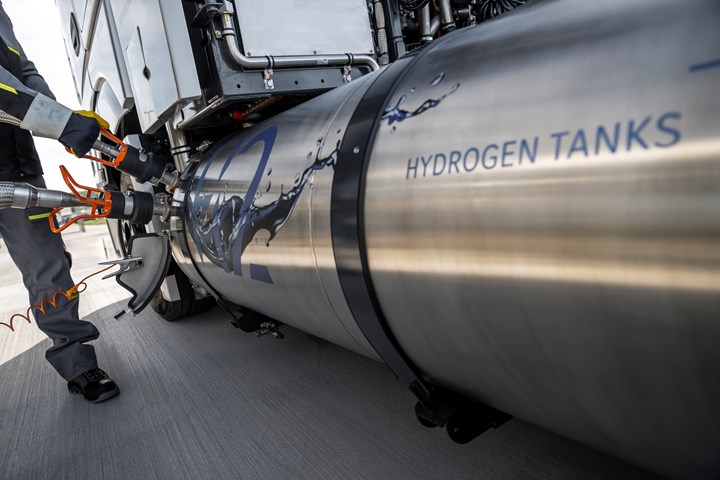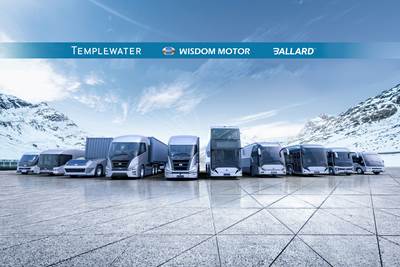Daimler Truck tests fuel-cell truck with liquid hydrogen
Mercedes-Benz GenH2 Truck fuel-cell prototype undergoes intensive testing via LH2 refueling to increase range for long-haul transport and improve carbon neutrality.

Mercedes-Benz GenH2 Truck prototype. Photo Credit, all images: Daimler Truck
Since last year, a Mercedes-Benz GenH2 Truck fuel-cell prototype has been undergoing intensive testing — both on the in-house test track and on public roads. (Stuttgart, Germany) is now putting another prototype into operation to test the use of liquid hydrogen (LH2), backed by political support from Daniela Schmitt, Minister of Economic Affairs of Rhineland-Palatinate. This announcement follows ’s (DTNA, Portland, Ore., U.S.) collaboration with (Columbus, Ind., U.S.) to upfit and validate Freightliner Cascadia trucks with a Cummins H2 fuel cell powertrain.
Recently, Daimler Truck says it celebrated the first successful LH2 refueling of the truck together with (Paris, France) using a newly installed prototype filling station at the development and testing center in Wörth, Germany. During the refueling process, cryogenic liquid hydrogen at -253ºC (-423ºF) is filled into two 40-kilogram (88-pound) tanks mounted on either side of the chassis. Vehicle tank insulation is said to keep the hydrogen at temperature for a sufficiently long time without active cooling.
Daimler Truck notes that it prefers LH2 in the development of hydrogen-based drives, as it has a higher energy density in relation to volume compared to gaseous hydrogen. As a result, more hydrogen can be carried, which significantly increases the range and enables comparable performance of the vehicle with that of a conventional diesel truck. The development objective of the series-ready GenH2 Truck is a range of up at least 1,000 kilometers (621 miles). This makes the truck suitable for flexible and demanding applications, according to the company, especially for heavy-duty long-haul transport. The start of series production for hydrogen-based trucks is planned for the second half of the decade.

Daimler tests fuel-cell truck with LH2.
At the same time, Daimler Truck is working together with (Dublin, Ireland) on the development of a new process for handling LH2 (“subcooled” sLH2 technology). Among other things, this innovative approach reportedly enables high storage density and easier refueling compared to LH2. The companies plan for the first refueling of a prototype vehicle at a pilot station in Germany in 2023. Daimler expects to collaborate with other companies and associations to develop their own refueling and vehicle technologies that apply the new LH2 standard and thereby establish a global mass market for the new process.
When it comes to infrastructure for hydrogen filling stations along important transport routes in Europe, Daimler Truck is also planning to work together with Shell, BP and TotalEnergies. Daimler Truck is also a shareholder in hydrogen filling station operator H2 Mobility Deutschland. In addition, Daimler Truck, IVECO, Linde, OMV, Shell, TotalEnergies and the Volvo Group have committed to work together to help create the conditions for the mass-market roll-out of hydrogen trucks in Europe as part of the H2Accelerate (H2A) interest group.
On its path towards a CO2-neutral future, Daimler Truck consistently pursuing a dual-track strategy in the electrification of its portfolio with both battery-electric and hydrogen-based drives. The ambition is to offer only new vehicles that are carbon-neutral in driving operation in its global core markets by 2039.
Related Content
Braided thermoplastic composite H2 tanks with co-consolidated molded boss areas to fit EV battery space
BRYSON project demonstrates possible designs, automated manufacturing and low permeability concepts, including EVOH liner and novel PPA matrix.
Read MoreTPI manufactures all-composite Kenworth SuperTruck 2 cab
Class 8 diesel truck, now with a 20% lighter cab, achieves 136% freight efficiency improvement.
Read MoreHonda begins production of 2025 CR-V e:FCEV with Type 4 hydrogen tanks in U.S.
Model includes new technologies produced at Performance Manufacturing Center (PMC) in Marysville, Ohio, which is part of Honda hydrogen business strategy that includes Class 8 trucks.
Read MoreSMC composites progress BinC solar electric vehicles
In an interview with one of Aptera’s co-founders, CW sheds light on the inspiration behind the crowd-funded solar electric vehicle, its body in carbon (BinC) and how composite materials are playing a role in its design.
Read MoreRead Next
Ballard Power and Wisdom Motor Co. partner to accelerate adoption of fuel cell commercial vehicles
As part of the collaboration, the companies plan to introduce and demonstrate a double-decker fuel cell bus in Hong Kong this year.
Read MoreUltrasonic welding for in-space manufacturing of CFRTP
Agile Ultrasonics and NASA trial robotic-compatible carbon fiber-reinforced thermoplastic ultrasonic welding technology for space structures.
Read MoreNext-gen fan blades: Hybrid twin RTM, printed sensors, laser shock disassembly
MORPHO project demonstrates blade with 20% faster RTM cure cycle, uses AI-based monitoring for improved maintenance/life cycle management and proves laser shock disassembly for recycling.
Read More












